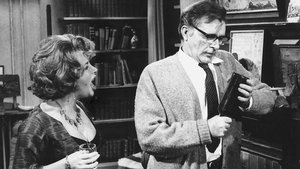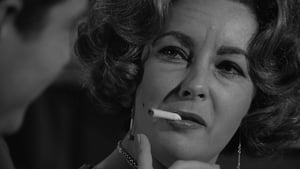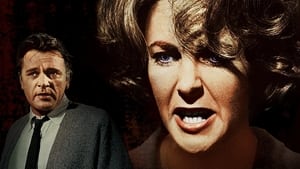Contact: info@alwanfilm.com
Video Sources 0 Views

Who’s Afraid of Virginia Woolf 1966 Colorized
Synopsis
Who’s Afraid of Virginia Woolf 1966 Colorized Review: A Dark, Emotional Drama Transformed in Color

Introduction
Who’s Afraid of Virginia Woolf? (1966), directed by Mike Nichols and based on Edward Albee’s celebrated play, is a landmark film in American cinema. Its sharp dialogue, intense performances, and brutal emotional undercurrents cemented it as one of the most significant dramas of the 1960s. The film’s original black-and-white cinematography was instrumental in creating its oppressive atmosphere, mirroring the emotional turmoil of its characters. Decades later, the debate about film colorization has raised new questions about how this classic would look and feel in color. In this review, we explore how the colorized version of Who’s Afraid of Virginia Woolf? reinterprets the film’s visual aesthetic, and we will discuss its broader significance in cinema history.
Check The Full Colorized Movies List
Check Our Colorized Movies Trailer Channel
Understanding Who’s Afraid of Virginia Woolf 1966 Colorized: Director, Cast, and Genre
Director’s Vision: Mike Nichols’ Cinematic Genius
Who’s Afraid of Virginia Woolf? marked the directorial debut of Mike Nichols, who later became one of Hollywood’s most respected filmmakers. Nichols approached the film with a clear vision: to retain the intimacy and intensity of Albee’s stage play while using the medium of film to delve deeper into the psychological nuances of the characters. His direction expertly captures the claustrophobia of the main characters’ world, creating an immersive, often uncomfortable viewing experience. Nichols’ ability to highlight the subtleties of the human condition while maintaining a fast-paced, biting narrative made the film a success both critically and commercially.
The Powerhouse Cast: Elizabeth Taylor and Richard Burton
The heart of Who’s Afraid of Virginia Woolf? lies in the explosive performances of its lead actors, Elizabeth Taylor and Richard Burton. As George and Martha, a bitterly married couple locked in an emotional battle, the two stars deliver career-defining performances that blend volatility, vulnerability, and devastating wit. Elizabeth Taylor’s portrayal of Martha is particularly notable for how it diverges from her glamorous image, presenting instead a raw, complex character. Taylor gained weight and shed her usual glamorous persona for the role, a move that paid off, earning her an Academy Award for Best Actress.
Richard Burton, as the disillusioned and equally sharp-tongued George, matches Taylor’s intensity with a performance that is subtle and nuanced. The real-life chemistry between Taylor and Burton, married at the time, lends an authenticity to the film’s depiction of a marriage in turmoil, making their verbal sparring all the more compelling.
Supporting actors George Segal and Sandy Dennis, who play the young couple caught in the storm of George and Martha’s dysfunction, also deliver strong performances. Their gradual unraveling over the course of the night, as they become more entangled in George and Martha’s toxic games, serves as a perfect counterpoint to the older couple’s explosive dynamic.
Genre: Psychological Drama at Its Best
Who’s Afraid of Virginia Woolf? is a quintessential psychological drama, a genre that focuses on the emotional and mental struggles of its characters. The film’s intense focus on dialogue and character interaction, coupled with its exploration of deep psychological themes, such as identity, reality, and delusion, makes it a powerful example of the genre. Nichols uses the trappings of domestic life—an ordinary living room, a night of casual drinks with guests—to reveal the extraordinary depths of human emotion and pain. The film’s stark realism, heightened by its originally stark black-and-white cinematography, is one of the reasons it has become a classic.
Exploring the Plot and Characters of Who’s Afraid of Virginia Woolf 1966 Colorized
Detailed Synopsis: A Night of Emotional Unraveling
The plot of Who’s Afraid of Virginia Woolf? unfolds over the course of one night, during which George and Martha, a middle-aged couple, invite a younger couple, Nick (George Segal) and Honey (Sandy Dennis), to their home after a university faculty party. What starts as a seemingly harmless late-night gathering quickly devolves into a nightmarish series of mind games, emotional manipulation, and vicious arguments.
Martha and George have spent years perfecting the art of cutting each other down, using alcohol and sharp-tongued banter as weapons in their psychological warfare. Throughout the night, they drag their guests into their toxic dynamic, exposing the younger couple’s insecurities and weaknesses in the process. As the night progresses, long-buried secrets come to light, and the lines between truth and illusion blur, culminating in a harrowing emotional climax that leaves both couples forever changed.
Characters: Complex, Flawed, and Utterly Human
One of the film’s most striking features is its character complexity. Martha, a force of nature, swings between cruelty, desperation, and vulnerability. Her battle with George is one of equals, even as it tears both of them apart. George, seemingly the quieter, more reserved of the two, reveals himself to be just as manipulative and damaged as Martha. Their toxic relationship is deeply layered, representing not just marital discord but broader themes of disillusionment and existential angst.
Nick and Honey, the younger couple, start the evening as outsiders but are quickly pulled into the older couple’s games. As the night progresses, their own flaws and weaknesses are exposed, revealing that beneath their youthful facade, they too are trapped in a marriage built on illusion.
The Art of Film Colorization
Understanding the Process of Film Colorization
Film colorization is a technique that involves digitally adding color to black-and-white films. Initially, colorization was done manually, frame by frame, but advances in digital technology have made the process more streamlined and accurate. In recent years, colorization technology has reached a point where filmmakers and restorers can closely approximate natural colors, though it remains an artistic choice rather than an exact science.
Colorizing a film like Who’s Afraid of Virginia Woolf?, originally conceived in black and white, involves careful consideration of the film’s aesthetic and emotional tone. The decision to add color must be balanced with the need to preserve the director’s original vision and the film’s atmosphere.
Early Colored Films: A Brief History
The Evolution of Color in Cinema
The history of color in film dates back to the early 20th century, when various techniques, such as hand-tinting and toning, were used to add color to films. The breakthrough came with the invention of Technicolor in the 1930s, which allowed filmmakers to create vibrant, full-color images. However, black-and-white films remained a dominant force in cinema, especially for films with a more serious or artistic tone, well into the 1960s.
By the time Who’s Afraid of Virginia Woolf? was released in 1966, color film technology was widespread, but director Mike Nichols deliberately chose to shoot in black and white to heighten the emotional intensity of the story and create a sense of stark realism. The absence of color reinforced the bleakness and emotional rawness of the characters’ lives.
Who’s Afraid of Virginia Woolf? and Its Colorized Version
The Decision to Release in Color
In the case of Who’s Afraid of Virginia Woolf?, colorization represents a new way to experience the film, allowing viewers to see it in a different light—literally. While the original black-and-white version emphasized the psychological tension and stark emotional landscape, the colorized version brings a new dimension to the film’s visual aesthetic.
Adding color to the film gives the set design, costumes, and actors a different texture. The colorized version highlights the drabness of the home, the weariness in the characters’ faces, and the exhaustion of their surroundings, offering viewers a fresh way to interpret the emotional weight of the story. However, this visual change can also alter the film’s mood, which may or may not align with Nichols’ original vision.
Impact on the Visual and Emotional Narrative
The black-and-white cinematography of Who’s Afraid of Virginia Woolf? was a deliberate choice, meant to reflect the emotional and psychological bleakness of the characters’ lives. The colorized version, while visually striking, inevitably changes this dynamic. The emotional power of the film lies in its claustrophobic atmosphere, which may be lessened when color is introduced.
At the same time, the colorized version offers a new way to experience the film, highlighting visual details that might go unnoticed in black and white. For example, the subtle differences in the characters’ costumes or the design of the living room set may become more apparent, adding to the film’s sense of realism.
The Debate Over Film Colorization
A Controversial Artistic Choice
Colorization has always been a subject of debate in the film world. Critics argue that it compromises the artistic integrity of classic films, particularly those like Who’s Afraid of Virginia Woolf? that were deliberately shot in black and white. The fear is that colorization may dilute the emotional power of the original film, reducing its impact by making it more visually conventional.
On the other hand, proponents of colorization argue that it can introduce classic films to new audiences who might otherwise be put off by black-and-white cinematography. By adding color, these films can be made more accessible and visually appealing to modern viewers.
Examining Who’s Afraid of Virginia Woolf? as a Colorized Film
Enhancement or Distraction?
The question of whether colorization enhances or distracts from Who’s Afraid of Virginia Woolf? is subjective. For some viewers, the colorized version may provide a new way to appreciate the film’s visual storytelling, offering a different perspective on the set design, costumes, and physical performances. For others, the introduction of color may detract from the film’s original aesthetic, making it feel less stark and emotionally raw.
Ultimately, whether the colorized version enhances or distracts from the film depends on the viewer’s preference. For fans of classic cinema, the black-and-white version will likely remain the definitive experience, while others may find the colorized version offers a fresh take on this timeless story.
Influence and Legacy: The Impact of Who’s Afraid of Virginia Woolf 1966 Colorized
A Turning Point in American Cinema
Who’s Afraid of Virginia Woolf? had a profound impact on American cinema, both for its content and its style. The film was groundbreaking in its frank portrayal of marriage, its explicit language, and its exploration of dark psychological themes. It challenged the boundaries of what could be depicted on screen and helped pave the way for the more daring, realistic films of the 1970s.
In terms of its visual style, Nichols’ decision to shoot in black and white in the mid-1960s was itself a bold choice. It set the film apart from the colorful, escapist fare that dominated Hollywood at the time and aligned it more closely with the European art films that were beginning to influence American directors.
The Lasting Impact of the Cast
Elizabeth Taylor’s performance in Who’s Afraid of Virginia Woolf? marked a turning point in her career. Known for her beauty and glamorous roles, Taylor’s transformation into the abrasive, deeply flawed Martha demonstrated her range as an actress and earned her critical acclaim. Richard Burton’s performance was equally praised, and the film remains one of the highlights of his career.
The film’s influence extended beyond its immediate release. It set a new standard for films about relationships and the emotional complexities of marriage, inspiring future filmmakers to explore similar themes in their own work.
Director’s Cinematic Legacy: Mike Nichols Beyond Who’s Afraid of Virginia Woolf 1966 Colorized
A Career Defined by Psychological Insight
Mike Nichols went on to have a long and successful career, directing such iconic films as The Graduate (1967), Catch-22 (1970), and Silkwood (1983). Known for his ability to draw out powerful performances from his actors and for his keen insight into the human psyche, Nichols became one of Hollywood’s most respected directors.
Who’s Afraid of Virginia Woolf? remains one of Nichols’ most celebrated works, not only for its bold storytelling but also for its technical mastery. The film’s success cemented Nichols’ reputation as a filmmaker capable of blending high art with mainstream appeal.
Themes Explored in Who’s Afraid of Virginia Woolf 1966 Colorized
Darkness, Violence, and Morality
At its core, Who’s Afraid of Virginia Woolf? is about the human capacity for self-destruction. The film explores how people use lies, illusions, and games to protect themselves from painful truths, often at the expense of their relationships. Themes of darkness and violence pervade the story, not in a physical sense, but in the emotional and psychological warfare that takes place between George and Martha.
The film also raises questions about morality and truth. George and Martha’s games are not just about hurting each other—they are also about facing, or refusing to face, the reality of their lives. The tension between illusion and reality is a central theme of the film, reflected in both the characters’ interactions and the visual style.
Reception and Controversy Surrounding Who’s Afraid of Virginia Woolf 1966 Colorized
Initial Critical Reception
When Who’s Afraid of Virginia Woolf? was released in 1966, it was met with critical acclaim. The film was praised for its bold performances, sharp dialogue, and unflinching look at marriage. Elizabeth Taylor’s transformation into the coarse, abrasive Martha was particularly lauded, and the film went on to receive 13 Academy Award nominations, winning five.
However, the film’s explicit language and dark themes also sparked controversy. The film pushed the boundaries of what was considered acceptable in Hollywood at the time, leading to debates about censorship and the role of adult content in mainstream cinema. Despite this, or perhaps because of it, the film became a box office success and remains one of the defining films of its era.
Controversy Surrounding the Colorized Version
As with many classic films, the decision to release a colorized version of Who’s Afraid of Virginia Woolf? has been met with mixed reactions. Purists argue that the colorized version undermines the film’s original aesthetic, while others see it as a valuable way to introduce the film to a new generation of viewers. Regardless of one’s stance on the issue, the colorized version has sparked a broader conversation about the preservation and reinterpretation of classic films in the digital age.
Where to Watch Who’s Afraid of Virginia Woolf 1966 Colorized Online
For those eager to experience Who’s Afraid of Virginia Woolf?, both the original black-and-white version and the colorized version are available on several streaming platforms, including Amazon Prime Video, Apple TV, and the Criterion Channel. DVD and Blu-ray versions, including the special edition with both versions of the film, can also be purchased online.
FAQs About Who’s Afraid of Virginia Woolf 1966 Colorized
Q: What is the significance of the colorized version of Who’s Afraid of Virginia Woolf??
A: The colorized version offers a new way to experience the film’s visual aesthetic, adding color to the set design and characters. However, it also alters the original black-and-white tone that director Mike Nichols intended.
Q: Who directed Who’s Afraid of Virginia Woolf??
A: The film was directed by Mike Nichols, marking his directorial debut in cinema.
Q: What are the key themes explored in the film?
A: The film explores themes of illusion vs. reality, emotional violence, and the complex dynamics of marriage and identity.
Q: How was the film received by critics?
A: Who’s Afraid of Virginia Woolf? received widespread critical acclaim, earning 13 Academy Award nominations and winning five, including Best Actress for Elizabeth Taylor.
Conclusion
Who’s Afraid of Virginia Woolf? (1966) remains a powerful, emotionally charged film that continues to resonate with audiences today. Mike Nichols’ direction, combined with unforgettable performances by Elizabeth Taylor and Richard Burton, creates a cinematic experience that is both intense and thought-provoking. While the colorized version offers a new visual perspective, the original black-and-white format remains essential to the film’s emotional impact.
As debates about film colorization continue, Who’s Afraid of Virginia Woolf? stands as a testament to the enduring power of classic cinema and the importance of preserving its artistic integrity. Whether viewed in black and white or in color, the film’s exploration of human relationships, identity, and emotional violence remains as relevant today as it was in 1966.













